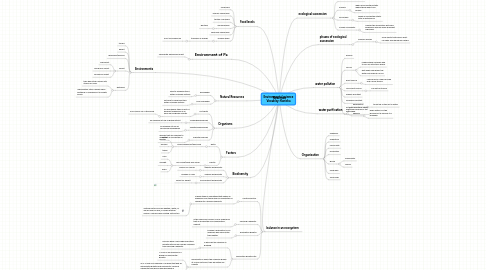
1. Environment of Pa
1.1. Temperate Deciduous forest
2. Food levels
2.1. Producers
2.2. primary consumers
2.3. tertiary cnsumers
2.4. decomposers
2.4.1. Bacteria
2.5. seconday consumers
2.6. Trophic levels
2.6.1. transefer of energy
2.6.1.1. only 10% passed on
3. Environments
3.1. tundra
3.2. desert
3.3. grassland/savanna
3.4. Forest
3.4.1. Rainforest
3.4.2. Deciduous forest
3.4.3. coniferous forest
3.5. wetlands
3.5.1. they help stop runnoff into strams an rivers
3.5.2. urbanization often causes urban wetlands in a parking lot or empty space
4. Factors
4.1. Biotic
4.1.1. Living organisms/was living
4.1.1.1. Plants
4.1.1.2. animals
4.1.1.3. twigs
4.2. Abiotic
4.2.1. non-living/never was living
4.2.1.1. rock
4.2.1.2. sunlight
4.2.1.3. wind
5. Biodiversity
5.1. Genetic biodiversity
5.1.1. Human vs. Human
5.2. Species biodiversity
5.2.1. Monkey vs. dog
5.3. Environment biodiversity
5.3.1. Forest vs. Desert
6. Organisms
6.1. Hot spots
6.1.1. An area where there is alot of different organisms in an area. like old grown forests
6.1.1.1. only covers 2% of the world
6.2. endangered species
6.2.1. an organism at risk of going extinct
6.3. Threatended species
6.3.1. an organism at risk of becoming endangered
6.4. indicater species
6.4.1. species that are required to show that an ecosystem is healthy
7. balance in an ecosystem
7.1. Limiting factors
7.1.1. is when there is something that keeps an organism from taking over an ecosystem or reaching its carrying cappacity
7.1.1.1. limiting factors can be weather, water, or like we use for deer, a longer hunting season. Humans have limiting factors too.
7.2. Carrying cappacity
7.2.1. is the maximum number of one organisms that an ecosystem can indeffinately support
7.3. population growth
7.3.1. is when a population of an organism has more births than deaths
7.4. population growth rate
7.4.1. is how fast an organism is growing
7.4.1.1. humans have a very high population growth rate and are quickly reaching their carrying cappacity
7.4.2. exponential is when the organism grows at a very fast pace. their poulation sky rockets
7.4.2.1. J-curve is an example of a graph for exponantial growth
7.4.2.2. an S-curve is an example of a graph that had an exponential growth and reached its carrying cappacity then had a large decrease in population.
8. New node
9. Natural Resources
9.1. Renewable
9.1.1. Able to replenish itslef within a human lifetime
9.2. Non renewable
9.2.1. not able to replenish itself within a human lifetime
10. Organization
10.1. Organsim
10.2. Population
10.3. community
10.4. ecosystem
10.5. Biome
10.5.1. Fresh water
10.5.2. Marine
10.6. Food web
10.7. food chain
11. ecological sucsession
11.1. when and ecosystem grows
11.2. Primary
11.2.1. when an ecosystem starts where there wasnt one before
11.3. Secondary
11.3.1. when an ecosystem starts after a disturbance
11.4. Climax community
11.4.1. is when the ecosystem gets very biodiverse and has many different organisms
12. phases of ecological sucsession
12.1. pioneer species
12.1.1. small plants that have a short life span and reproduce rapidly
13. water pollution
13.1. erosion
13.2. run off
13.2.1. impermeable surfaces lead to run off into storm drains
13.2.2. wet lands slow down the water and reduce run off
13.3. point source
13.3.1. coming form a specific pipe and can be traced
13.4. Non-point source
13.4.1. can not be traced
13.5. organic pollutant
13.6. inorganic pollutant
13.7. all these pollutions affect everyone because of the watershed.
14. water purification
14.1. desalination
14.1.1. to get rid of the salt in water
14.2. aquifers
14.2.1. when water is in the ground but is pure so it is drinkable
